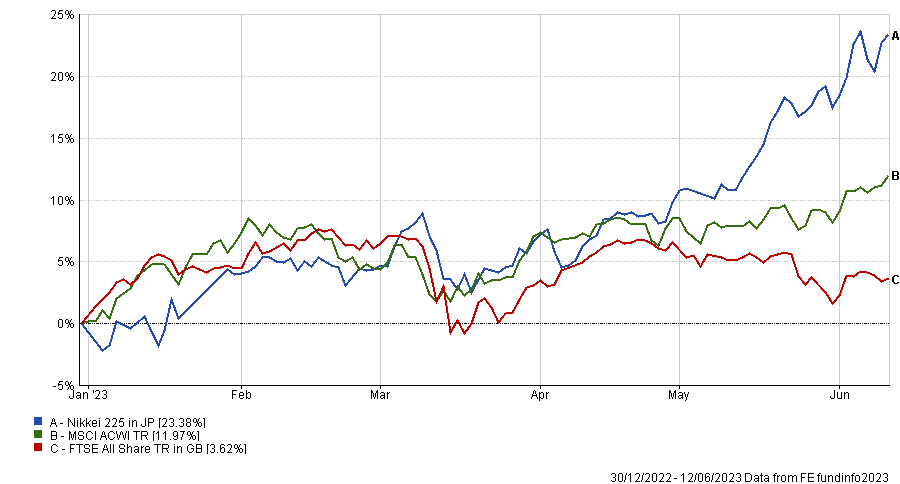Japan's Nikkei 225 stock market index has surpassed 33,000, a milestone not witnessed since 1990, but should investors be considering buying into this previously-unloved country?
Multiple factors have boosted investor interest in Japan’s stock market, with the recent endorsement from legendary investor Warren Buffett drawing further attention to the region.
The Nikkei 225 is up close to 24% in 2023 so far (in yen terms), exceeding the local currency returns of the MSCI AC World index by more than double. It’s also around 20 percentage points ahead of the FTSE All Share.
Performance of indices in 2023

Source: FE Analytics
Hal Cook, senior investment analyst at Hargreaves Lansdown, said: “Interest in the Japanese stock market is at its highest for a long time, with professional and retail investors alike choosing to add some additional exposure to the country.”
Cook noted that a significant number of multi-asset and global equity fund managers are adding to Japanese equities. A blend of positive economic indicators seems to be adding to Japan's allure, including a recently revised Q1 2023 GDP growth figure of 0.7%, sticky inflation (Japan has suffered from deflation for decades), continued ultra-loose monetary policy and ongoing corporate governance reform.
However, the optimism is tempered by past experiences. Japan has faced many false dawns over the past decade, which always prompts the question ‘Is it different this time?’
“Well, Warren Buffett thinks it is, with his very public trip to Japan in April and confirmation that he had increased his investments in some of the country’s companies seemingly acting as a catalyst for others to join him,” Cook said.
“Similarly, Japanese equity managers we have spoken to recently echo his enthusiasm, noting both an increase in potential client enquiries for their funds as well as net inflows from existing clients.”
Nonetheless, there remains the risk that Japan’s rally is just a momentum trade or bubble.
“It’s often uncomfortable when it feels like you are ‘jumping on the bandwagon’ as it’s quite possible you’ve already missed most of the gains,” Cook said.
“However, the number of potential positive factors for this market over the next few years, meaning investors with a long-time horizon could be rewarded, even if there is a correction downwards over the short term.
“Not least that unlike other developed markets, Japan has not been raising interest rates – meaning cash has significantly less appeal against inflation. Officials have pointed to the $7trn sitting in cash in Japan – if that flows towards the stock market it will be a welcome accelerant.”
For investors considering buying into the Japanese market, Hargreaves Lansdown highlighted three funds.
Performance of funds vs sector over 5yrs

Source: FE Analytics
The first is the FSSA Japan Focus fund, which is run by FE fundinfo Alpha Manager Martin Lau and Sophia Li. Since launch in October 2015, the fund has made a 122% total return – the third highest in the IA Japan sector.
“It's performed exceptionally well since launch, boosted by the managers' astute stock-picking,” Cook said. “The managers look for high quality companies that are dominant in their industries. This gives it a growth style bias.”
This style is out of favour at the moment, which has led to some short-term underperformance. However, with assets of £210m, Cook argued that the fund is nimble enough to “pounce” on growth opportunities.
The second fund is Man GLG Japan Core Alpha, which currently top-quartile over one, three, five and 10 years. Managed by Jeff Atherton since March 2011 with Adrian Edwards joining in 2014, the fund has a value approach to investing.
“Atherton has built over three decades of experience investing in Japanese equities,” Cook explained. “He uses a clear, disciplined approach, which has served the fund well over the long term.”
The third fund pick is one for investors who prefer tracking an index over active management: iShares Japan Equity Index.
Cook said it is a good option to get access to a broad spread of Japanese companies at low cost, thanks to an ongoing charges figure of just 0.08%.





